Navigation
Install the app
How to install the app on iOS
Follow along with the video below to see how to install our site as a web app on your home screen.
Note: This feature may not be available in some browsers.
More options
Style variation
-
Congratulations MintJulep on being selected by the Eng-Tips community for having the most helpful posts in the forums last week. Way to Go!
You are using an out of date browser. It may not display this or other websites correctly.
You should upgrade or use an alternative browser.
You should upgrade or use an alternative browser.
Bridge collaspe in India 10
- Thread starter oldrunner
- Start date
- Status
- Not open for further replies.
-
1
- #22
Possible issues from renovating the Morbi footbridge
(1) New deck has 4 instead of 3 longitudinal beams in the old deck
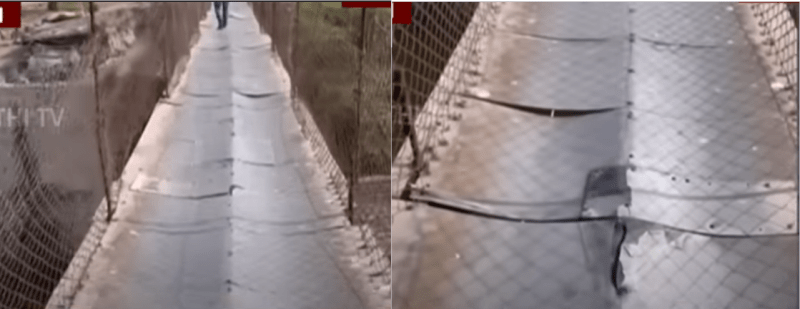
From the old bridge before renovation the deflected deck clearly shows 3 longitudinal beams, one at each side plus one at the middle, to give the above symmetrical deflected dish shapes.

From the East tower hanging twisted deck and the debris the bridge deck after renovation has 4 longitudinal beams. This may cure the symmetric dish-shape deflection but the new deck's dead weight from the beam alone has increased by a factor of 1.33. The new deck surface also appears to be thicker possibly laminated with a hard wearing material.
(2) The height of the chinalink fence, as safety barrier, has been extended.
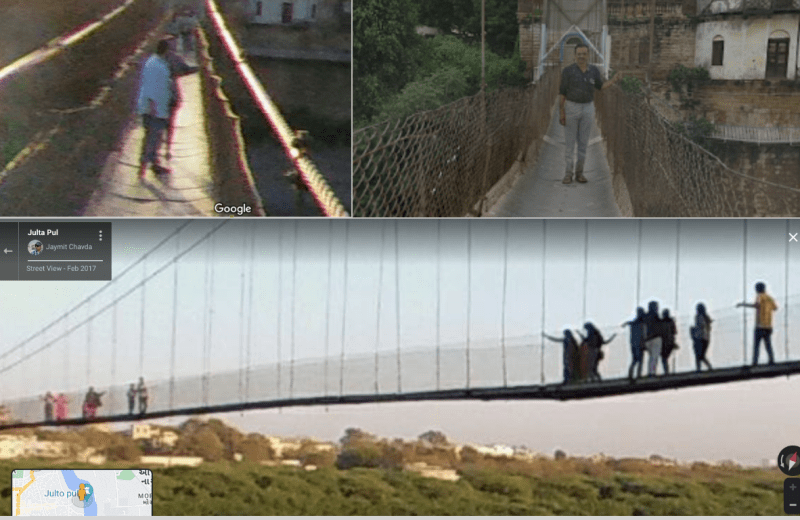
The old footbridge before renovation had a chainlink fence height which I estimate to be 1.2m to allow adults comfortably placing their hands on top of the fence.

The renovated footbridge has a new chainlink fence barrier clearly a lot higher than before as no pedestrian was seen taller than the fence. My estimate of the new height is that it is at least 2m as chainlink fence comes in standard sizes. The higher chainlink fence barrier is safer but the new height could increase the chainlink fence dead weight by a factor of 1.66.
(3) Main cables were not replaced during renovation.
According to the preliminary investigation hearing the main cables were not replaced during renovation. The snapped off end has a fair amount of rust. Early evidence suggests the failure likely to have occurred at the top of the tower where each cable would pass over a pulley or saddle wheel which is used to balance out any unequal lateral force generated between the central and side span. Some Indian engineers have complained the cable should have been oiled or greased when passed over a saddle wheel. The lack of oil or grease could generate friction harmful to the cable.
It is not easy to snap off a steel cable with a universal safety factor of 5.
Observation
It is a miracle if the original design calculation of this 143 old bridge still exists. However even with an old general arrangement drawing and the limited foundation details a competent engineer can ascertain the capacity of each component by verifying its size, dimensions and material type. Thus selectively changing some components of the original design has to be back up by calculation that the capacity of the system has not been compromised. Extending the height and adding new beam will increase weight and that will have impact on the capacities of the deck, hangers, main cables, steel towers, connections, anchors and foundations.
The person who made decision on changes to the original design would have the knowledge that this bridge wobbles and vibrates. Thus the competency of the parties handling this renovation will be under a magnifying glass now.
(1) New deck has 4 instead of 3 longitudinal beams in the old deck

From the old bridge before renovation the deflected deck clearly shows 3 longitudinal beams, one at each side plus one at the middle, to give the above symmetrical deflected dish shapes.

From the East tower hanging twisted deck and the debris the bridge deck after renovation has 4 longitudinal beams. This may cure the symmetric dish-shape deflection but the new deck's dead weight from the beam alone has increased by a factor of 1.33. The new deck surface also appears to be thicker possibly laminated with a hard wearing material.
(2) The height of the chinalink fence, as safety barrier, has been extended.

The old footbridge before renovation had a chainlink fence height which I estimate to be 1.2m to allow adults comfortably placing their hands on top of the fence.

The renovated footbridge has a new chainlink fence barrier clearly a lot higher than before as no pedestrian was seen taller than the fence. My estimate of the new height is that it is at least 2m as chainlink fence comes in standard sizes. The higher chainlink fence barrier is safer but the new height could increase the chainlink fence dead weight by a factor of 1.66.
(3) Main cables were not replaced during renovation.
According to the preliminary investigation hearing the main cables were not replaced during renovation. The snapped off end has a fair amount of rust. Early evidence suggests the failure likely to have occurred at the top of the tower where each cable would pass over a pulley or saddle wheel which is used to balance out any unequal lateral force generated between the central and side span. Some Indian engineers have complained the cable should have been oiled or greased when passed over a saddle wheel. The lack of oil or grease could generate friction harmful to the cable.
It is not easy to snap off a steel cable with a universal safety factor of 5.
Observation
It is a miracle if the original design calculation of this 143 old bridge still exists. However even with an old general arrangement drawing and the limited foundation details a competent engineer can ascertain the capacity of each component by verifying its size, dimensions and material type. Thus selectively changing some components of the original design has to be back up by calculation that the capacity of the system has not been compromised. Extending the height and adding new beam will increase weight and that will have impact on the capacities of the deck, hangers, main cables, steel towers, connections, anchors and foundations.
The person who made decision on changes to the original design would have the knowledge that this bridge wobbles and vibrates. Thus the competency of the parties handling this renovation will be under a magnifying glass now.
If the cable went over a roller or sheave of some kind on the towers then some movement is anticipated or at least allowed for. Repeated cable movement over sheaves prompts a ton-miles calculation and a replacement schedule; if not this is an oversight. The flexing creates fatigue as well as wear, and perhaps the extra stress accelerates corrosion at that point. Question for those who work with such things: would you not expect to see a replacement schedule, even from 1879? The late Victorian-era Brits were not ignorant of such things by any means.
LittleInch
Petroleum
Not knowing where that break is is crucial and not known.
The amount of movement on top of the tower will be really quite low as the only movement is coming from thermal expansion / stretch of the back stay.
Similarly the amount of flexing is quite low at the top of the tower. Only if the wire wasn't carefully guided and ended up as a straight edge with a small radius of curvature would you see some sort of long term fatigue I think.
My suspicion is that this was at one of the first clamp like connections to a down comer / rod which could have been subject to flexing loads as people walked over the bridge for years and slowly started snapping cores until no more than 1/5 of the original was left. That snapped end is crucial and I hope it is preserved and removed carefully by whoever investigates these things in India.
No idea how long a cable on a suspension bridge is supposed to last. This may just be the original!
Remember - More details = better answers
Also: If you get a response it's polite to respond to it.
The amount of movement on top of the tower will be really quite low as the only movement is coming from thermal expansion / stretch of the back stay.
Similarly the amount of flexing is quite low at the top of the tower. Only if the wire wasn't carefully guided and ended up as a straight edge with a small radius of curvature would you see some sort of long term fatigue I think.
My suspicion is that this was at one of the first clamp like connections to a down comer / rod which could have been subject to flexing loads as people walked over the bridge for years and slowly started snapping cores until no more than 1/5 of the original was left. That snapped end is crucial and I hope it is preserved and removed carefully by whoever investigates these things in India.
No idea how long a cable on a suspension bridge is supposed to last. This may just be the original!
Remember - More details = better answers
Also: If you get a response it's polite to respond to it.
-
1
- #25
LionelHutz
Electrical
I wish I could tell from a couple of pictures that one structure must weight 133% more than another structure or that one chain link fence must weight 166% of another one.
If you read the text carefully I said the weight of beams, due to number increase, would go up. Similarly as well as for the weight of the chain link fence weight would go up if it is higher. These weight increases are parts of the deck's dead weight.
Since a professional engineer can be sued for negligence I always prepare for how I would defend myself in court before I ever have to alter a design that has worked satisfactory before. That goes for every repair, change, strengthening and substitution of different materials when the original no longer available from the market throughout my professional life. The rule is one doesn't change something that works unless one can justify it in a court of law.
-
1
- #27
saikee119 said:the weight of beams, due to number increase, would go up
While I'll go along with this for the chain-link fence, it's not necessarily true for the beams or the deck. If the original beams were three channels weighing 25plf, and they were replaced with four channels weighing 14plf, we increased the number of beams but decreased the total weight. Similarly, if I went to two 50plf channels, the total number of beams would go down but the weight would go up.
The deck looks thicker, but it also doesn't look like steel. The logo on the bottom suggests it's some kind of manufactured panel. Perhaps a lighter weight composite. Hard to say.
So it's quite possible that the dead load was maintained very close to the original value. Allowing the cable to relax while removing the old and adding the new, however, could have initiated fractures in the core of the main cable. I don't do much with cable structures, though, and have not had an opportunity to do any forensic work on them.
-
1
- #28
I don't know the existing design but I would expect the channel to be structural grade. To replace 3 with 4 channels the total second moment of area or the I-value should be comparable otherwise the bending stress will not be the same as before. Scaled from the previous photo the depth of the channel is about 125mm.
The deck seems be some kind of proprietary board. However I believe the longitudinal channels have to be "structurally integrated" with the decking membrane in order to be able to act compositely. Thus there is a requirement each channel to be rigidly held to the decking membrane to effect the transfer of stresses, at least within each hanger bay. The site photos suggest there are shear stubs/shear connectors/bolts between each deck segment with the channels. One photo shows 3 pull-out holes for each of the two outer beams and two holes for each of the inner two beams.
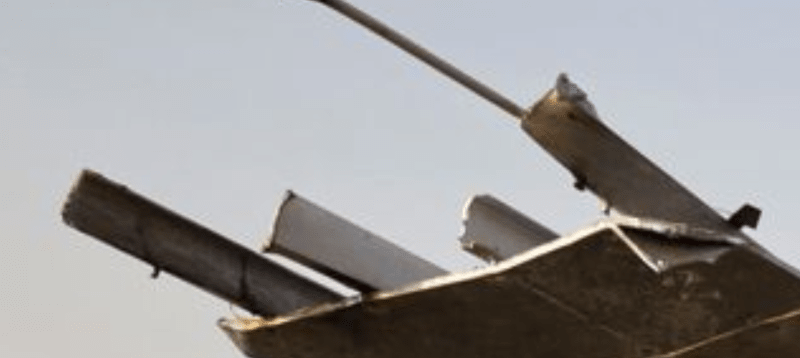
Bolts or stubs or shear connectors are visible after deck separation
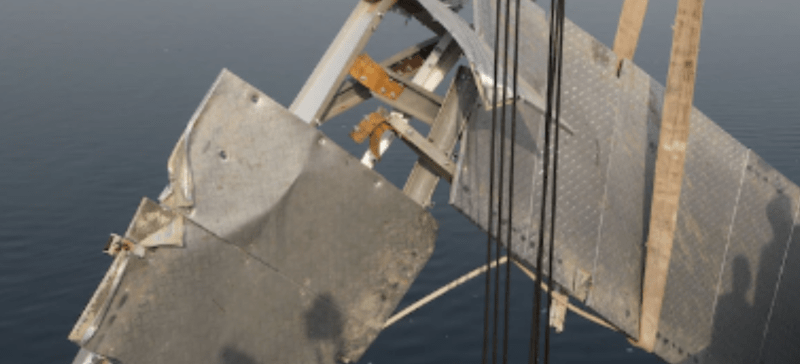
Deck plate pull-out holes visible. 3 for outer beam and 2 for inner beam per panel. Deck plate has chequer pattern so likely of standard steel chequer plate.
I'm not a structural by any stretch but the following is interesting. Read the paragraph starting "Questions have been raised":
Politicians like to panic, they need activity. It is their substitute for achievement.
Politicians like to panic, they need activity. It is their substitute for achievement.
LittleInch
Petroleum
They are going down the easy route of blaming the little people and over crowding instead of lack of inspection or maintenence of the main cable.
The company involved doesn't appear to be very experienced though.
Remember - More details = better answers
Also: If you get a response it's polite to respond to it.
The company involved doesn't appear to be very experienced though.
Remember - More details = better answers
Also: If you get a response it's polite to respond to it.
LionelHutz
Electrical
While I'll go along with this for the chain-link fence, it's not necessarily true for the beams or the deck.
I don't go along with it for the chain link fence. They can make it will varying wire gauges.
Alistair_Heaton
Mechanical
Chain link fence differences
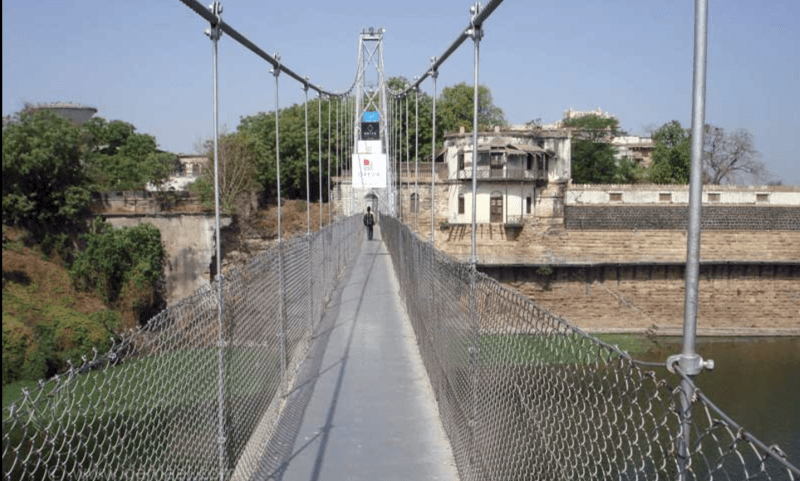
This is the best photo on the old chainlink fence I got from the Internet. It was dated 2008 according to the description. If you download and magnify it you will see the fence is shorter than the pedestrians at the far end. Also the fence had three fixings per hanger rod. Thus the fence prevents the pedestrian falling out of the bridge by the three restraining horizontal wires threaded through the three fixings at each hanger.
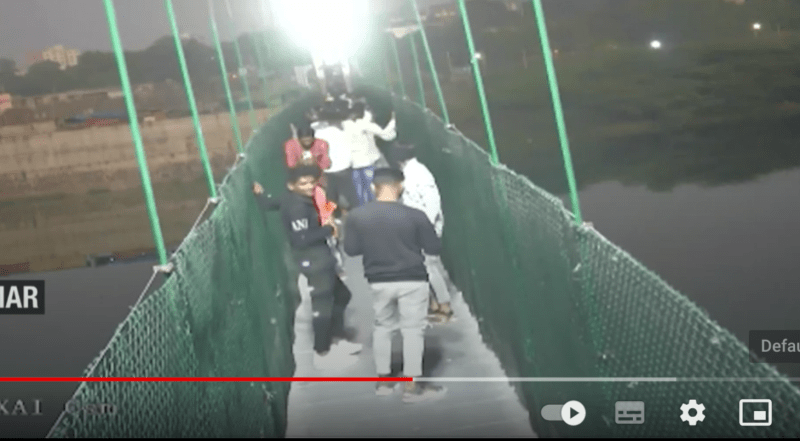
The new chainlink fence appeared to have been coated with PVC and well higher than every pedestrian in the photo. It is impossible to establish if the new fence was made from a lighter gauge wire.
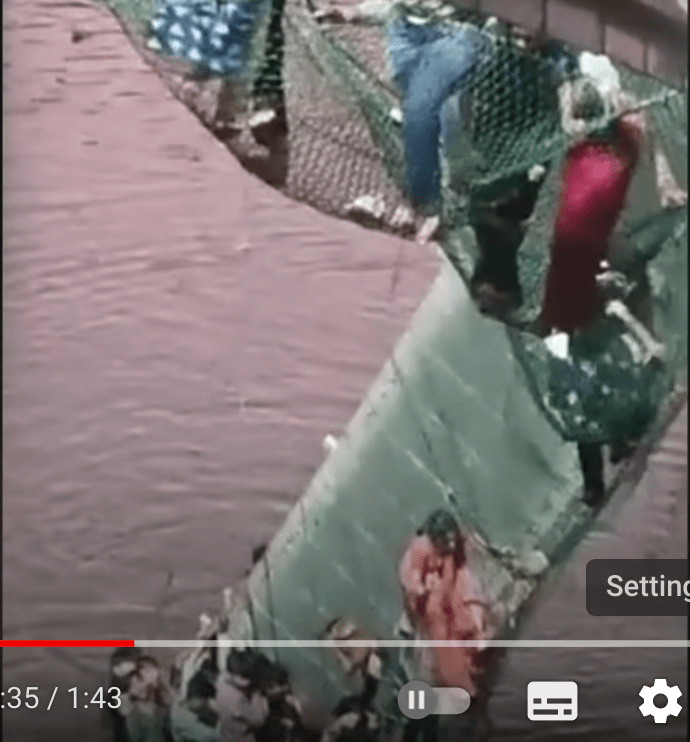
After the collapse it can be seen the taller-than-before chainlink fence was strong enough to save some pedestrians who were seen walking on the fence up or down the deck wreckage.
It would be my expectation that a prosecuting judge will have to ask anyone substituting the existing fence with a lighter gauge alternative to justify his/her decision if a pedestrian accidentally falls off the bridge due to a weaker or more flexible barrier than before.

This is the best photo on the old chainlink fence I got from the Internet. It was dated 2008 according to the description. If you download and magnify it you will see the fence is shorter than the pedestrians at the far end. Also the fence had three fixings per hanger rod. Thus the fence prevents the pedestrian falling out of the bridge by the three restraining horizontal wires threaded through the three fixings at each hanger.

The new chainlink fence appeared to have been coated with PVC and well higher than every pedestrian in the photo. It is impossible to establish if the new fence was made from a lighter gauge wire.

After the collapse it can be seen the taller-than-before chainlink fence was strong enough to save some pedestrians who were seen walking on the fence up or down the deck wreckage.
It would be my expectation that a prosecuting judge will have to ask anyone substituting the existing fence with a lighter gauge alternative to justify his/her decision if a pedestrian accidentally falls off the bridge due to a weaker or more flexible barrier than before.
Why did this bridge collapse, how was it an engineering failure?
—-There is a significant difference in this chainlink fence: its height, and the green plastic coating. A simple conclusion for direct cause-of-collapse is: the celebrants acted like the bridge was some kind of carnival ride. Does the chainlink fence significantly contributed toward suppressing a natural fear of shaking a high bridge?—-one, by reason of its increased height above eye-level; and two, the green coating at peak visual wavelengths, visually obscuring the surroundings. It seems reasonable the increased height, and the vinyl-coating, worked together to lessen the self-preservation instinct: fear of high water-crossing. Possibly the green color itself, in terms of a color-psychology, is a factor as well. (Someone else can ask Rudolph Steiner what he might say
—-There is a significant difference in this chainlink fence: its height, and the green plastic coating. A simple conclusion for direct cause-of-collapse is: the celebrants acted like the bridge was some kind of carnival ride. Does the chainlink fence significantly contributed toward suppressing a natural fear of shaking a high bridge?—-one, by reason of its increased height above eye-level; and two, the green coating at peak visual wavelengths, visually obscuring the surroundings. It seems reasonable the increased height, and the vinyl-coating, worked together to lessen the self-preservation instinct: fear of high water-crossing. Possibly the green color itself, in terms of a color-psychology, is a factor as well. (Someone else can ask Rudolph Steiner what he might say
LionelHutz
Electrical
It's a rather piss-poor design if people trying to sway or jumping on a suspension bridge like this one is something that would collapse it.
-
1
- #39
LittleInch
Petroleum
The issue on this bridge is simply the apparent lack of condition monitoring or inspection of the main supporting cables.
There is no way on earth those cables should have failed even if the whole bridge was full of people all doing the hokey Kokey.
I strongly suspect all the work was simply on the walking deck replacement and the side mesh and no one inspected or looked at the main cables if they were out of reach.
It's not clear how often or if the cables are replaced from the original ones over 100 years ago.
Remember - More details = better answers
Also: If you get a response it's polite to respond to it.
There is no way on earth those cables should have failed even if the whole bridge was full of people all doing the hokey Kokey.
I strongly suspect all the work was simply on the walking deck replacement and the side mesh and no one inspected or looked at the main cables if they were out of reach.
It's not clear how often or if the cables are replaced from the original ones over 100 years ago.
Remember - More details = better answers
Also: If you get a response it's polite to respond to it.
-
2
- #40
Rather than piss-poor design, it looks like the problem was a failure in bridge inspection. It's been mentioned above (by LittleInch on November 1) that it appears that the main support cable had already had some strand failures before the event. Surely a real bridge inspection would have turned this up, and closed the bridge.
When was the last bridge inspection? The previous one?
Did the inspector examine that area of the cable (apparently the saddle, or near)?
What did the inspector report?
Who was the inspector?
Who did the inspector work for?
In a way, this reminds me of the Arecibo failure.
I'll note that I was composing the above just before LittleInch posted. I'll leave it as-is.
spsalso
When was the last bridge inspection? The previous one?
Did the inspector examine that area of the cable (apparently the saddle, or near)?
What did the inspector report?
Who was the inspector?
Who did the inspector work for?
In a way, this reminds me of the Arecibo failure.
I'll note that I was composing the above just before LittleInch posted. I'll leave it as-is.
spsalso
- Status
- Not open for further replies.
Similar threads
- Replies
- 0
- Views
- 3K
- Replies
- 0
- Views
- 6K
- Replies
- 343
- Views
- 93K
- Question
- Replies
- 27
- Views
- 28K
- Replies
- 2
- Views
- 8K

![[ponder] [ponder] [ponder]](/data/assets/smilies/ponder.gif)